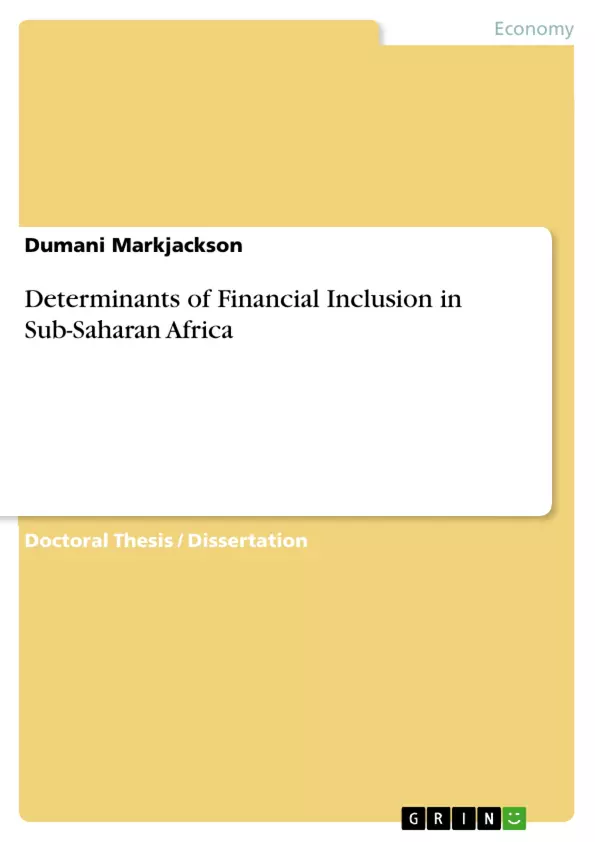The study examines the determinants of access to and usage of financial services in sub-Saharan Africa. The study employed panel data spanning 2006 to 2018 from 12 sub-Sahara African countries. The ex-post facto research design and econometric techniques were employed to explain the determinants of financial inclusion. The descriptive statistics was employed to describe the nature of the data. The LLC and IPS tests of stationarity indicated that all the variables were stationary at first difference. The Pearson pairwise correlation test revealed that the strength of association among the regressors were weak. The panel data was estimated using Pooled OLS, Fixed Effects, and Random Effects panel estimation techniques.
The findings show that aside GDP per capita and political stability that had insignificant effect on access; money supply and regulatory quality had a significant effect on access to financial services. Furthermore, the findings suggest that aside from regulatory quality and deposit rate, GDP per capita and automated teller machine exerts a significant effect on financial usage. The study further reveals that money supply and lending rate significantly stimulates usage of loan accounts, while regulatory quality was insignificant.
The study concludes that a combination of macroeconomic, institutional, and bank-level factors determine the level of financial inclusion in sub-Saharan Africa. The study recommends that regulators should encourage a conducive environment that spurs competition and innovation in the private sector. This may encourage financial access and usage due to economic growth and rising GDP per capita levels. Regulators should adopt policies like Regulatory Impact Assessment (RIA) in order to enhance the regulatory quality and boost public confidence. Regulators and banks should encourage the expansion of the number of functional point of service outlets in the region. Finally, government agencies should formulate policies that would encourage socio-political stability for the financial service industry to strive in the region.
Inhaltsverzeichnis (Table of Contents)
- Chapter 1: Introduction
- 1.1: Background to the Study
- 1.2: Statement of the Problem
- 1.3: Research Questions
- 1.4: Objectives of the Study
- 1.5: Significance of the Study
- 1.6: Scope and Limitations of the Study
- 1.7: Organization of the Study
- Chapter 2: Literature Review
- 2.1: Conceptual Framework
- 2.2: Theoretical Framework
- 2.3: Empirical Review
- 2.4: Summary of the Literature
- Chapter 3: Research Methodology
- 3.1: Research Design
- 3.2: Population and Sampling Techniques
- 3.3: Data Collection Techniques
- 3.4: Data Analysis Techniques
- Chapter 4: Data Presentation and Analysis
- 4.1: Descriptive Statistics
- 4.2: Inferential Statistics
- 4.3: Discussion of Findings
- Chapter 5: Summary, Conclusion and Recommendations
- 5.1: Summary of Findings
- 5.2: Conclusion
- 5.3: Recommendations
- References
Zielsetzung und Themenschwerpunkte (Objectives and Key Themes)
This dissertation aims to investigate the determinants of financial inclusion in Sub-Saharan Africa. It examines various factors that contribute to or hinder access to financial services for individuals and businesses in the region. The research utilizes empirical data analysis to explore the relationships between these determinants and the level of financial inclusion.
- The role of financial institutions and their impact on financial inclusion
- The influence of government policies and regulations on financial access
- The impact of technological advancements on financial inclusion
- The relationship between financial inclusion and economic development
- The role of poverty and inequality in shaping financial inclusion levels
Zusammenfassung der Kapitel (Chapter Summaries)
Chapter 1 provides a comprehensive introduction to the study, outlining its background, problem statement, research questions, objectives, significance, scope, and limitations. It establishes the context for the research and highlights the importance of financial inclusion in Sub-Saharan Africa.
Chapter 2 presents a thorough review of the existing literature on financial inclusion, focusing on theoretical and conceptual frameworks, as well as empirical studies conducted in various contexts. This chapter critically analyzes previous research findings and identifies gaps in existing knowledge.
Chapter 3 outlines the research methodology employed in the study, including the research design, population and sampling techniques, data collection methods, and data analysis techniques. It provides a detailed explanation of the research process and ensures the methodological rigor of the study.
Chapter 4 presents and analyzes the data collected for the study, utilizing various statistical techniques to examine the relationships between determinants of financial inclusion and its level in Sub-Saharan Africa. The findings are discussed and interpreted within the context of existing literature and research questions.
Schlüsselwörter (Keywords)
Financial inclusion, Sub-Saharan Africa, financial institutions, government policies, technology, economic development, poverty, inequality, empirical analysis, determinants.
- Quote paper
- Dumani Markjackson (Author), 2021, Determinants of Financial Inclusion in Sub-Saharan Africa, Munich, GRIN Verlag, https://www.grin.com/document/1437588



